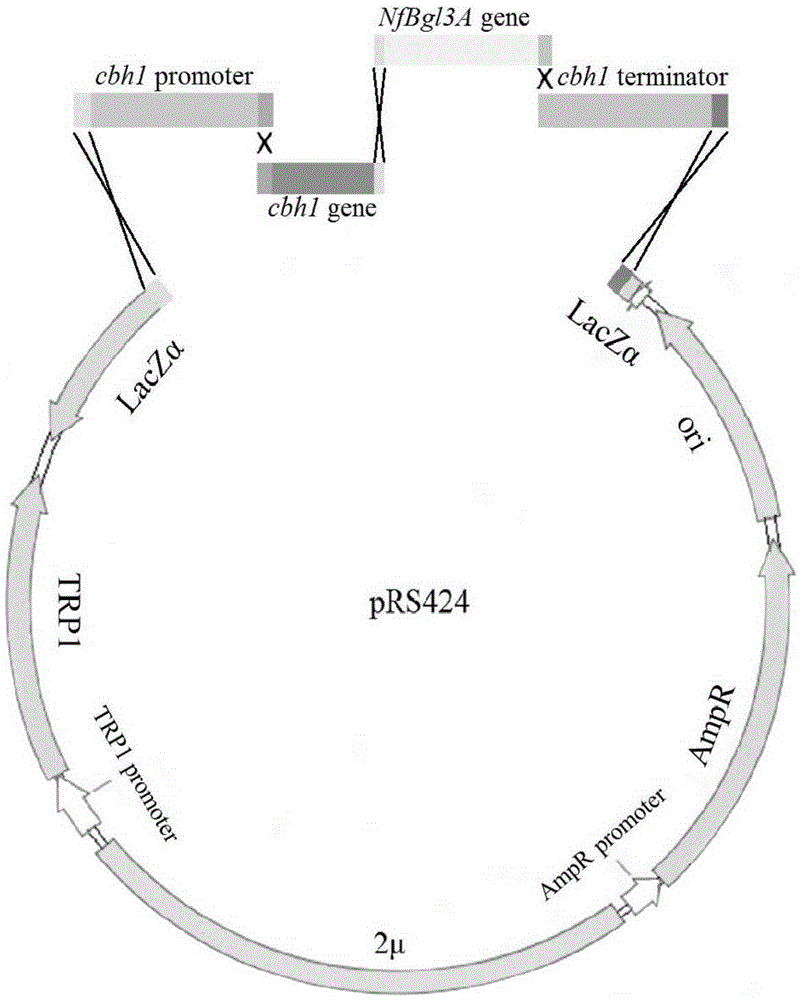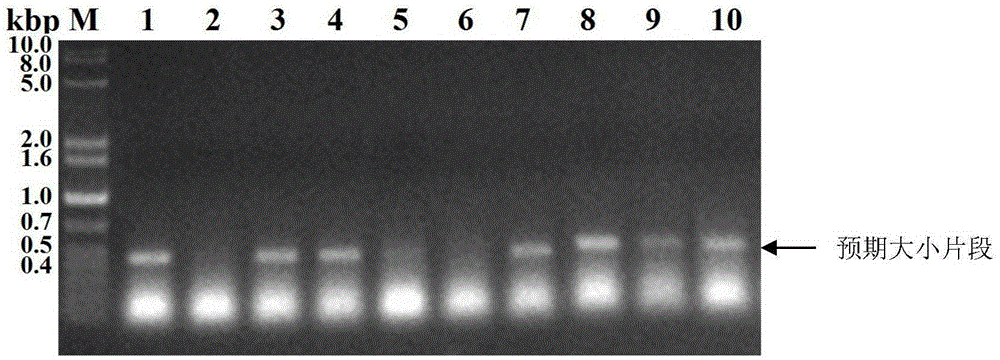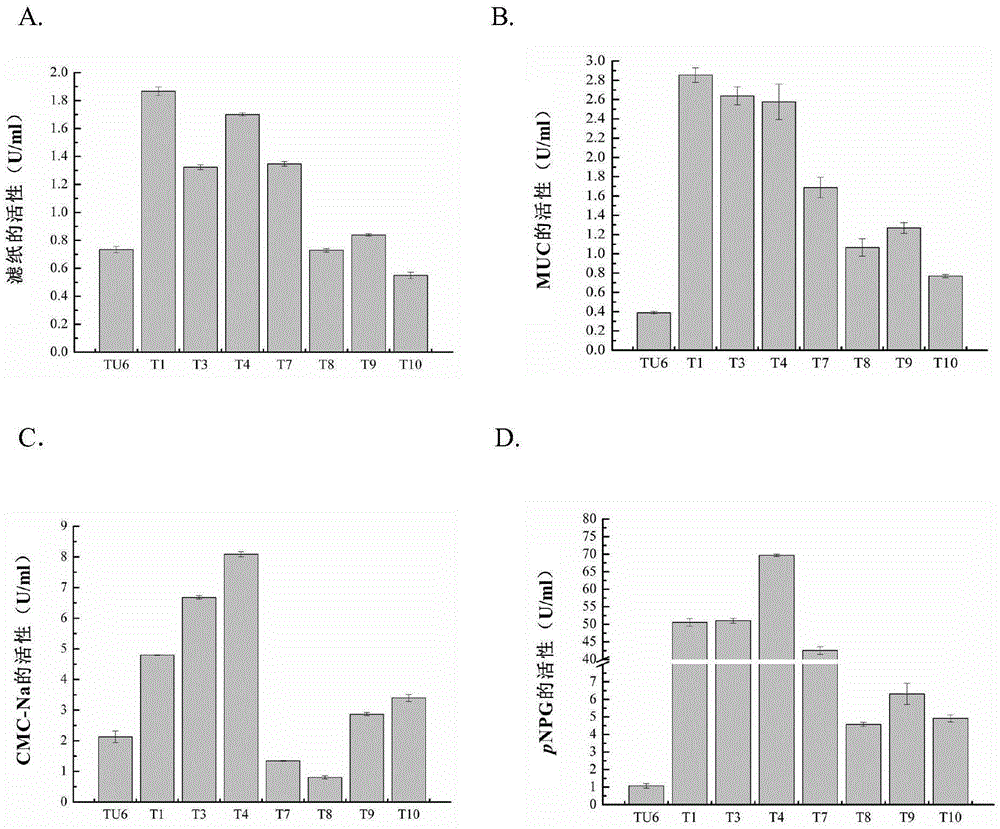Method for improving enzyme activity of cellulose of trichoderma reesei
A technology of Trichoderma reesei and enzyme activity, applied in the field of genetic engineering, can solve the problems of limiting the effective utilization of cellulose and low activity
- Summary
- Abstract
- Description
- Claims
- Application Information
AI Technical Summary
Problems solved by technology
Method used
Image
Examples
Embodiment 1
[0024] Example 1 Construction of recombinant plasmid pRS424-cbh1-NfBgl3A expressing N.fischeriP1 derived β-glucosidase
[0025] The pRS424-cbh1-NfBgl3A was constructed and transformed into Trichoderma reesei. Under the drive of cbh1 promoter, mRNA was transcribed and translated into CBH1-NfBgl3A fusion protein. The recognition site RDKR sequence of Kex2 protease is designed between CBH1 and NfBgl3A. Therefore, the fusion protein is recognized and cut by Kex2, thereby finally obtaining free CBH1 and β-glucosidase (NfBgl3A).
[0026] The schematic diagram of the plasmid construction of pRS424-cbh1-NfBgl3A is as follows figure 1 shown.
[0027] Amplification of the cbh1 promoter
[0028] Using the genomic DNA of Trichoderma reesei Tu-6 as a template, the cbh1 promoter was amplified with Trcbh1pF (5'-TGAGCGCGCGTAATACGACTCACTATAGGGCGAATTGATATCTAGAGTTGTGAAGTCGG-3') and Trcbh1pR (5'-GCACAATACGACTCCGGCGCTGGCCGATGCGCAGTCCGCGGTTGACTATT-3') primers.
[0029] The PCR reaction conditi...
Embodiment 2
[0041] Example 2. Transformation of the pRS424-cbh1-NfBgl3A plasmid into Trichoderma reesei
[0042] Preparation of pyr4 gene expression cassette DNA
[0043] The pyr4 gene expression cassette was amplified by PCR from the genomic DNA of Trichoderma reesei QM9414, electrophoresed on 1% agarose gel, and the target band in the PCR product was excised, and the DNA was purified for future use. The primers used were: Ppyr4f: 5'-GACTAGACTGACCCCCCCGGTTGGG-3' and Ppyr4r: 5'-CAACTGCATCCAAACCATCTACC-3'.
[0044] The PCR reaction conditions were: 95°C×5min; 32 cycles of 94°C×30s, 55°C×30s, 72°C×1min; 72°C×10min; storage at 4°C. Perform electrophoresis on 1% agarose gel, cut out the target band in the PCR product, and purify the DNA.
[0045] Transformation of Trichoderma reesei Tu-6
[0046] Trichoderma reesei Tu-6 (ATCCMYA-256) was purchased from American Type Culture Collection, USA. Trichoderma reesei Tu-6 was inoculated on a potato medium (PDA) plate, and cultured statically at...
Embodiment 3
[0047] Example 3. Screening of recombinant transformants
[0048] Transformants were grown and selected on MM-glucose agar medium containing 1M sorbitol. A single clone was picked, inoculated in 25ml liquid MM-glucose, and cultured with shaking at 30°C and 180rpm for 1d. Genomic DNA was extracted, and the plasmid pRS424-cbh1-NfBgl3A was successfully transformed into Trichoderma reesei cells by PCR. The primers used in PCR were: Yanzh-Trchb1F (5'-GTTCGGACCCATTGGCAGCACCGG-3') and Yanzh-Nf739R (5'-AAGCGGATACCTAGCGGCGAGTCCTG-3').
[0049] The PCR reaction conditions were: 95°C×5min; 32 cycles of 94°C×30s, 55°C×30s, 72°C×1min; 72°C×10min; storage at 4°C. On 1% agarose gel electrophoresis, there were 7 transformants with DNA bands of the same size as expected (such as figure 2 shown). Therefore, these transformants were positive transformants with pRS424-cbh1-NfBgl3A plasmid. These transformants were inoculated on PDA medium, cultured statically at 30°C for 7 days to produce s...
PUM
 Login to View More
Login to View More Abstract
Description
Claims
Application Information
 Login to View More
Login to View More - R&D
- Intellectual Property
- Life Sciences
- Materials
- Tech Scout
- Unparalleled Data Quality
- Higher Quality Content
- 60% Fewer Hallucinations
Browse by: Latest US Patents, China's latest patents, Technical Efficacy Thesaurus, Application Domain, Technology Topic, Popular Technical Reports.
© 2025 PatSnap. All rights reserved.Legal|Privacy policy|Modern Slavery Act Transparency Statement|Sitemap|About US| Contact US: help@patsnap.com



